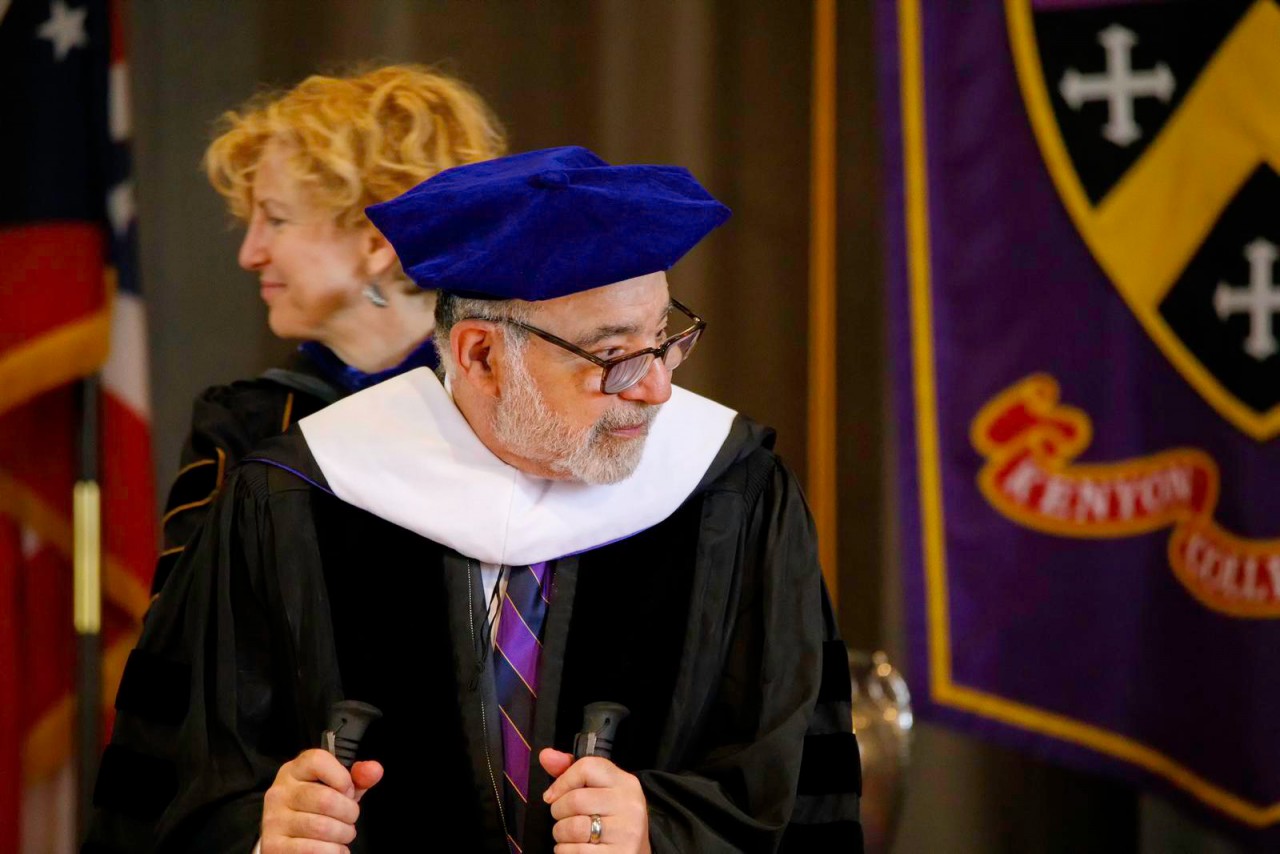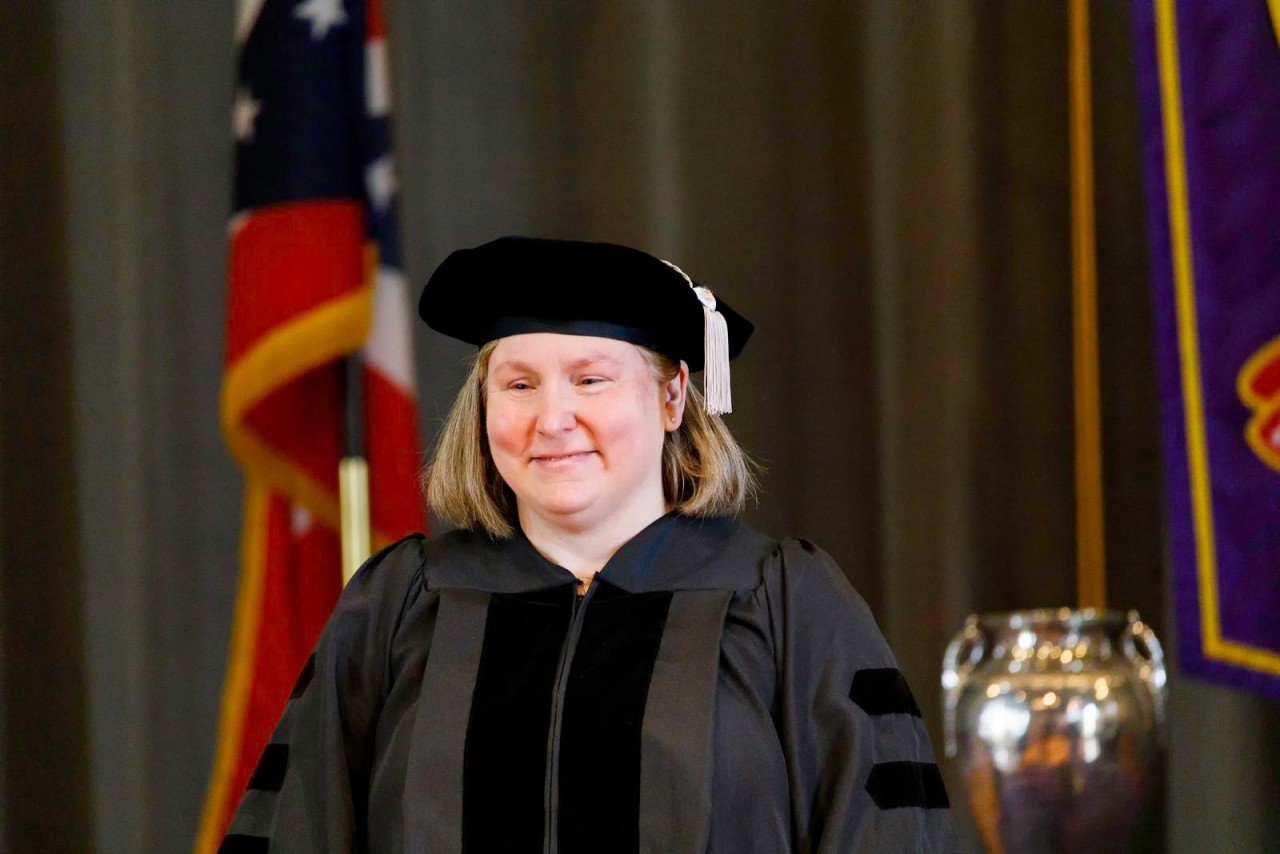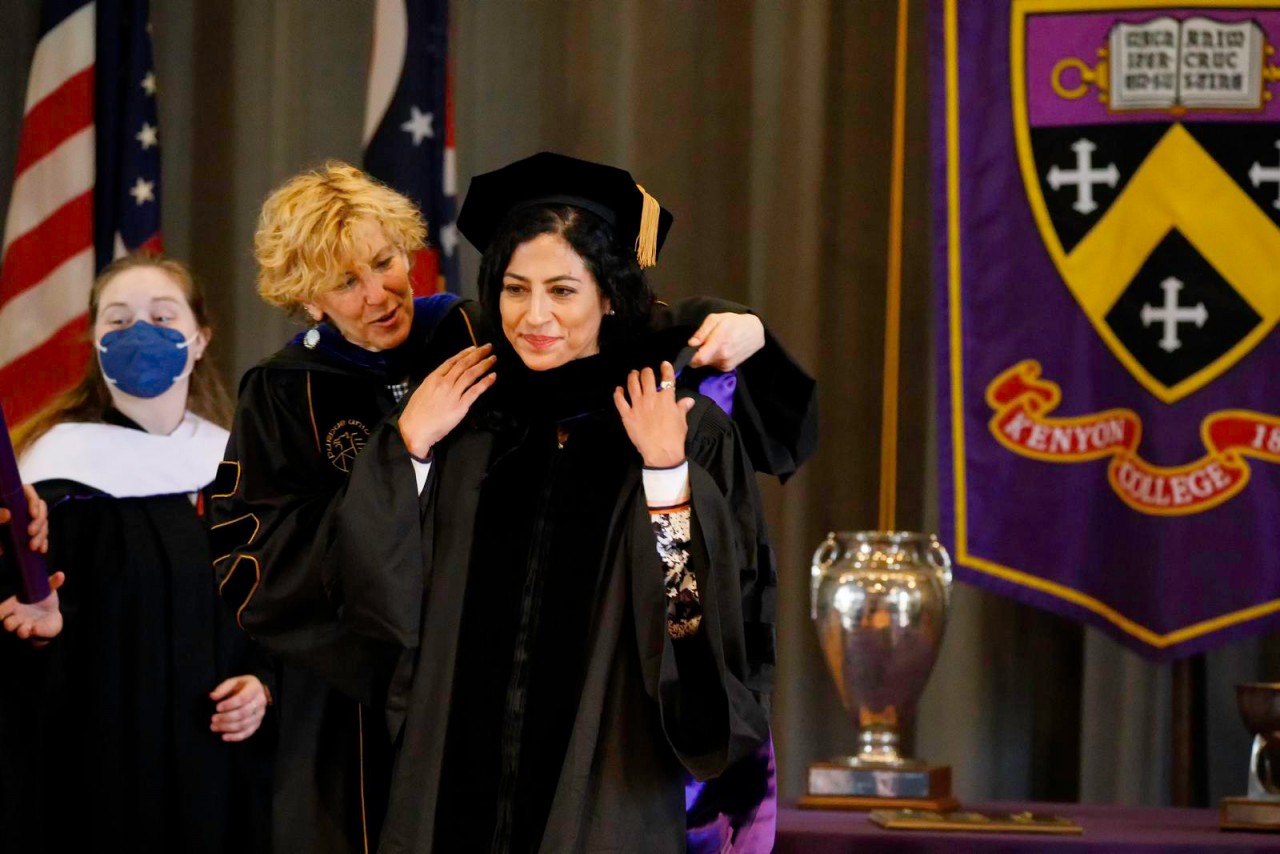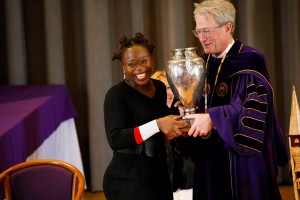The following are the prepared texts of remarks delivered by 2023 alumni honorary doctorate recipients. Note: Julie Ann Cerel’s remarks reference her work in suicide prevention.
David Lewis Bergman ’72
I am very humbled to be here. I always knew that Kenyon left a profound mark on me, but until now, I had no sense that I had left any mark on Kenyon whatsoever, certainly not one that deserves this honor. Kenyon changed my life. For the first time, I felt that I belonged not despite my eccentricities, but because of them. That I wrote poetry was not ridiculed, but led to my lifelong friendship with Daniel Mark Epstein. And it was not only students who accepted my oddities, but wonderful teachers like Bill McCulloh and Robert Daniel and the whole faculty. For what Kenyon stressed was individuality, developing the strength and wisdom to find one’s own path in life. Kenyon hoped that we would all become gadflies, a term used to describe Socrates, who was so often discussed in class that I almost expected to find him walking along Middle Path.
 I wrote my honors thesis on the poet W. H. Auden, comparing his first book to what was then his most recent collection. That new book, “About the House,” celebrated the home he made with his partner, Chester Kallman. I wrote in the thesis that a visitor to their house must confront its “urbane, homosexual, artistic atmosphere, and the visitor has to face the two who have themselves faced the world squarely, bravely and with love. … He must confront a living and working religion.”
I wrote my honors thesis on the poet W. H. Auden, comparing his first book to what was then his most recent collection. That new book, “About the House,” celebrated the home he made with his partner, Chester Kallman. I wrote in the thesis that a visitor to their house must confront its “urbane, homosexual, artistic atmosphere, and the visitor has to face the two who have themselves faced the world squarely, bravely and with love. … He must confront a living and working religion.”
Today that statement seems bland, except in Florida, but it was written in 1972. I wrote it 50 years ago, and at that time, homosexuality was a crime in all but one state. It was still regarded as a disease by the medical institutions and regularly treated with drugs and electroshock therapy. Those who were arrested often lost their jobs, their families and their homes. Homosexual acts were, at that time, grounds for expulsion from Kenyon. But to the credit of the Kenyon faculty, not one reader suggested that I cut those lines or tone them down, or even write about something else. And my very first essay on gay literature, “Alternative Families: Fathers in Recent Gay American Fiction” appeared in the Kenyon Review, then edited by two of my teachers, Galbraith Miller Crump and Phil Church. It was brave of them to publish it because it was the very first essay that took the emerging gay literary movement seriously as literature. The copyeditor was very nervous. Instead of referring to the authors as “writers who wrote on gay subjects,” as the copyeditor wished, I called them “gay writers,” and such a term was then considered slanderous. “How do you know that such a writer is gay,” I was asked, and I answered, “I slept with him.” I never again had to prove in this way my intimacy with a literary subject.
So my work in gay literary studies started here, or more precisely in Leonard Hall where I lost both my fear of rejection and my virginity. For those losses and for so many gains, I thank you all.
Julie Ann Cerel ’94
Suicide.
It is an uncomfortable word. I have spent my professional life with that word every single day. I have spent my time thinking about how people get to the point where life is not worth living and how to help turn things around into lives worth living. I have spent time with suicide loss survivors who pick up the pieces after this most unimaginable loss. And I have tried to quantify how common this experience is so that the half of us who know someone who dies by suicide feel a little less alone.
 Before I go any further, I would like you to do one thing that can actually help someone you care about if they are feeling stressed or hopeless or suicidal. Pull out your phone and put the number 988 into it. That is the new national suicide prevention helpline and is available 24/7 to anyone who is in need of help or cares about someone who they want to stay alive.
Before I go any further, I would like you to do one thing that can actually help someone you care about if they are feeling stressed or hopeless or suicidal. Pull out your phone and put the number 988 into it. That is the new national suicide prevention helpline and is available 24/7 to anyone who is in need of help or cares about someone who they want to stay alive.
I wanted to spend some time today talking about things I was told along the way of my academic journey and how, despite these, I have gotten to this place. I am talking about this, not to be bitter or reflect on times that were uncomfortable, but to have you think about experiences many of us have had and how other people’s opinions do not need to define you.
Once, here at Kenyon, I was told by a professor that I was not “as smart” as my peers; I wasn’t one of the “brilliant minds” in their classroom.
I had a Kenyon classmate tell me our friendship no longer suited her because I was not “intellectual enough” when I joined Peeps our senior year.
As a graduate student, a faculty mentor deigned to tell me that I probably would not be successful in my field if I continued to prioritize a good night’s sleep.
And, a trusted mentor later tried to sum up my career trajectory in what I suppose he thought was cute since I was moving to Kentucky — by saying ‘there are work horses and show ponies and you are a work horse.”
If it wasn’t enough to hear these things as a student or trainee, as a member of the faculty I was once told, by a colleague, in a public meeting, that “we don’t need more people like you here.” I assume she was talking about psychologists in social work. Or maybe people who prioritized research over teaching. Or people whose research focused on suicide? But it was hard not to take it personally.
It is hard not to internalize these messages.
Yet, I stand before you today as someone who prides myself on being plainspoken and an intellectual, someone who continues to prioritize sleep and is a recognized leader in my field, and someone who has contributed to my College, my University, my community, and to a meaningful body of research — all in spite of others doubt. I’ve long since abandoned trying to define myself as a workhorse or a show pony and have embraced that, if we have to use the analogy, I am both. I often talk about myself as a dinosaur princess. I am getting older all the time and can feel stuck in the past but I am also drawn to the sparkly and new. You don’t have to be one thing.
When I first began to study suicide and those left behind when someone dies by suicide, I was talking to a grants officer who boldly stated that “grief is grief” and suicide bereavement is not a public health issue. Despite this lack of enthusiasm for my research, I persisted. I knew that what I was learning was important and impactful — so I kept going down this path — making people uncomfortable by talking about something that for generations our society just swept under the rug.
Honestly, I never expected to spend my entire career thinking about suicide — professionally. But it has taught me that when there is a need, there is something we can all do to fill that. If I can use my intellect, curiosity, and perseverance to continue to advance knowledge and best practices in this area, I’m making a difference. And, isn’t that what we all learned at Kenyon — to use our individual talents and ability to think and reason to find our place in the world. But it also means I am ardent that my free time is not deliberately spent thinking about sad things — I screen books and movies and TV shows to make sure there won’t be a suicide to surprise me and make me cry (I hate crying in my free time). I take pictures of puppies and rainbows and sunsets. I watch all the gymnastics practices I can. And I sleep. Because I need sleep. Because we all need sleep.
Some of the best advice I can give to each of you is that none of us should ever define ourselves by our worst days. Don’t define yourself by other people’s judgments of you or the things that they casually say. And we all have those moments. It is so hard, in these moments to remember to be true to yourself, pursue excellence, and accept that people will always be quick to judge or label. You’re not defined by others’ judgements.
The best advice I received when I started my tenure track position was to “keep your head down and do good work.” Kenyon played a huge role in the person I have become. Thanks to all the amazing faculty members, like Dr. Smolak, who shaped my early career and to my mentors and colleagues who have kept me going. Also thanks to my incredible family and friends who have supported me as I have pursued work in a field that can be filled with sadness but often ends up in a place of hope. Not everything is as it seems. You can be a workhorse and a show pony. You can be a dinosaur princess.
I am so grateful for this. An honorary Ph.D. defies my wildest imagination.
Marela Zacarías ’00
Thank you, Professor Esslinger, for your words, and thank you, Kenyon Board of Trustees, for this incredible honor. I’m happy to report that everything I learned while being a student here is still at the core of my practice.
I grew up in Coyoacán, Mexico City, the neighborhood where Frida Kahlo’s house and museum can be visited, which I did almost every year since I can remember. Being so familiar with Frida’s life and legacy from an early age made me think that it was common knowledge that women could be artists, have a strong political voice and that our indigenous past needed to be defended and honored.
 My mother Zaira reinforced this “common knowledge” by being herself. She was a single mother who studied physical anthropology, worked in archeological sites uncovering and identifying ancient skeletons; went on to get a masters in urban planning while she was pregnant with me and was the first woman to work at her company leading teams in the research and design of irrigation plans for the communities that needed them the most. As a child, she would take me out of my Montessori school to travel the country with her, interviewing indigenous farmers, sleeping in hammocks in the outskirts of towns, stopping by every archeological site we could find where she would tell me the stories of the people who once lived there. When she turned 40, she had become disillusioned by both the government’s disregard of her research and their practice of allocating funds to develop projects in towns as political favors instead of on proven need. So she decided to go back to school to study art, opened a Lebanese pastry business, and sold honey-dripping desserts in exchange for having the freedom to be an artist.
My mother Zaira reinforced this “common knowledge” by being herself. She was a single mother who studied physical anthropology, worked in archeological sites uncovering and identifying ancient skeletons; went on to get a masters in urban planning while she was pregnant with me and was the first woman to work at her company leading teams in the research and design of irrigation plans for the communities that needed them the most. As a child, she would take me out of my Montessori school to travel the country with her, interviewing indigenous farmers, sleeping in hammocks in the outskirts of towns, stopping by every archeological site we could find where she would tell me the stories of the people who once lived there. When she turned 40, she had become disillusioned by both the government’s disregard of her research and their practice of allocating funds to develop projects in towns as political favors instead of on proven need. So she decided to go back to school to study art, opened a Lebanese pastry business, and sold honey-dripping desserts in exchange for having the freedom to be an artist.
I went to a big public high school in the heart of Coyoacán. I was a bohemian teenager involved in social movements, known by my peers as an artist, a writer, and as someone who got very good grades even though I liked to party. The idea of studying in the States came to me after I studied English at an ESL school in Harvard Square the summer of my junior year. Being among college and graduate students living independently and in harmony inspired me to pursue a liberal arts education.
I’ve always wanted to thank John Anderson, the Dean of Admissions at Kenyon College at the time, for knowing that I was the right match for Kenyon and that Kenyon was meant for me. When I came here in 1996 I was the only student from Mexico. The community of students and professors welcomed me in and showed an interest in learning more about my culture. Professor Esslinger pretty much adopted me into her family.
I felt empowered by representing all that I had left behind, so I joined ADELANTE — which unlike today, only had two other Latin American members and many students who had come back from studying abroad in Spanish-speaking countries. I was president for the following two years, bringing speakers, musicians and hosting community events.
Early on I decided that my major would be “Social Movements Through Art and Religion,” a synoptic major I created combining fine arts, political science and religious studies. I had to find a professor in each department willing to sit down with one another to map out all my classes and requirements and meet with me regularly as my advisors. Thank you Professor Klesner, Professor Garhart and Professor Rhodes for jumping into this academic adventure with me. We did it! My thesis was called “Mural Art as a Tool for Social Change” and it entailed designing a 200-foot mural for a park in La Condesa neighborhood of Mexico City, that was inspired by the social and political situation at the time in both the U.S. and Mexico, calling for a better future. I painted a mockup of the mural in watercolor for my senior show and I designed a website where you could click on any image leading you to the research behind it. Because of the all encompassing nature of my studies I became very close to many professors in many departments and their support and guidance made me feel confident about my work and vision.
During my freshman year, Michael Rose, a senior, asked Ben Pomeroy and I to become the managers of the Horn Gallery. The Horn was a 100-year-old barn recently converted into a gallery, band rehearsal and community space where we also hosted poetry readings, dinners and concerts. Ben and I were committed and successful partners in bringing diverse communities of students together through the arts. By sophomore year The Horn was very popular and we won an award for best student organization of the year. Unfortunately, after one of our crowded concerts we noticed that the floors were starting to cave in, so we reached out to the administration. A team came to assess the building and we were told that it wasn’t safe for us to be there and that our beloved building had to be demolished. However, having proven that we were filling an important need for the student body, the college fundraised half-a-million dollars to build a new Horn, the 23-year-old building you have now. While construction happened we continued our programming from a trailer and when the new building was done at the end of our senior year, we had a big joyous gathering, a student play and my senior art show in the basement to celebrate it. Through the four-year experience of running the Horn, Ben and I became best friends, still are, and we keep in touch with many alumni around the country who were part of the Horn family (including my husband, Weston Pew, class of 2002). By supporting our vision and building a new Horn, Kenyon College showed us what it feels like to be recognized and encouraged for bringing the community together through art.
I graduated feeling empowered and maybe a little invincible, which lasted just long enough to introduce myself with a firm handshake as a mural artist (even though I had yet to paint a real mural) to anyone who would listen in Washington, D.C. I must have sounded convincing because the summer after graduating I was given the opportunity to paint my first 100 feet x 25 feet public mural in Columbia Heights, leading 100 volunteers. Many more murals would come after, then graduate school and now monumental permanent sculptural installations, gallery and museum shows.
So thank you Frida, thank you mom, thank you Kenyon professors, administrators and student community for giving me the strength, knowledge and confidence to live the life of an artist with a strong political voice who continues to defend and honor our indigenous past.
